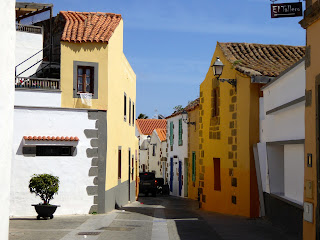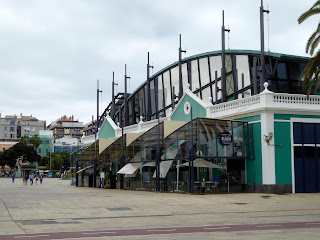There were many cactus plants growing around the public gardens in the town. This was a particularly tall variety.
The neo classical church peeps through the narrow walkway we followed on our walk into the town centre. The interior of the church is baroque but unfortunately as it was closed we didn't get to see inside .
The town square where locals and tourists congregate in the shade of the trees.
We drove on into the mountains to the Guayadeque Valley famous for its Aboriginal cave houses on the side of steep hillside cliffs. We visited the Cave Museum in the valley which was built into the rock and connected with the caves within where people had once lived. Risco de Vicentico is the largest existing settlement in the valley where there are over 100 caves which vary in size and accessibility.
Many of the caves have been enlarged by digging out the rock and many had grain silos for grain storage, excavated into the walls or the floor.
Apart from these dwelling caves, several funeral caves containing dozens of human remains (below ) are also found in the settlement. Analysis of human remains has demonstrated the importance of vegetables in the diet in Gran Canaria as quite distinctive from the other islands. It appears that meat consumption was low compared to vegetables. Barley was the main crop followed by wheat, lentils, figs, and beans were also grown in the valley.
This is the replica bedroom/living room of a cave house in the museum. We went into the genuine house a little later when we moved on to the village where all the cave homes were. Our guide was a friend of the 80 year old lady who allows her to take small groups of people into her home. There are two more bedrooms at the back of this room. The temperature indoors stays the same all year around.
One of the two restaurants in the village.
More cave homes on a lower slope.
The front door of the home we visited which was light and attractive, and quite a contrast to the dark interior which had a very stale smell because of the lack on ventilation and the lighting was very dim.
The lady's husband died last year and she wants to spend the remainder of her days there.
The restaurant where we had dinner. An interesting and great experience but the food wasn't the best.
The Bar that leads into the dining area.
Back in La Palmas we had a wander into town the next day which was interesting. The boat above in the Santa Catalina Park was a replica of Christopher Colombus's sailing ship.
This was a large gathering of men in the park who were playing Dominoes which is very popular over this side of the world.
Another bronze statue. Think the Boy will be waiting a long time if he wants his shoes polished!!
The Elder Science and Technology museum where NOT touching is forbidden. The museum was once a dockside warehouse.
So now our next stop is Agadir in Morocco.
























Love the bronze camel , such an interesting place to put it . Perhaps Richard could of got a ride on it after having his shoes cleaned. The bar at the restaurant is so wonderfully wobbly . Looking forward to seeing Agadir . X
ReplyDelete